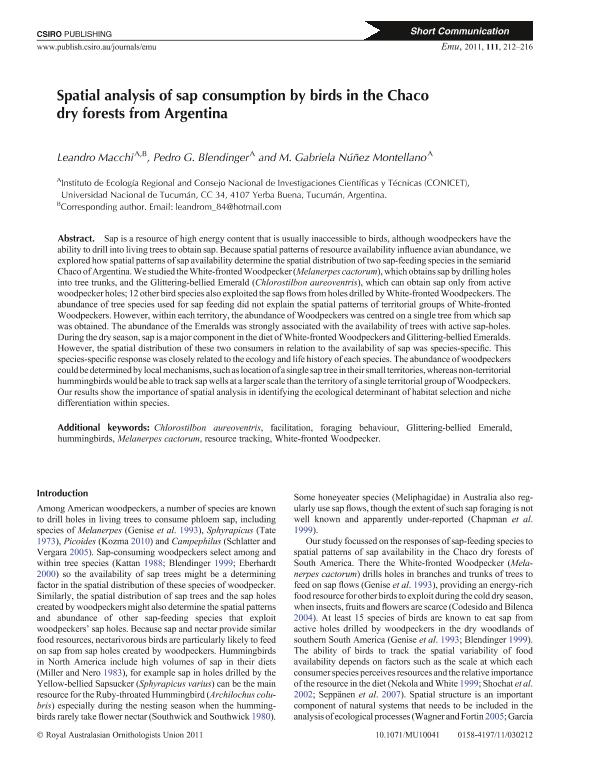Artículo
Spatial analysis of sap consumption by birds in the Chaco dry forests from Argentina
Fecha de publicación:
08/2011
Editorial:
Csiro Publishing
Revista:
Emu
ISSN:
0158-4197
Idioma:
Inglés
Tipo de recurso:
Artículo publicado
Clasificación temática:
Resumen
Sap is a resource of high energy content that is usually inaccessible to birds, although woodpeckers have the ability to drill into living trees to obtain sap. Because spatial patterns of resource availability influence avian abundance, we explored how spatial patterns of sap availability determine the spatial distribution of two sap-feeding species in the semiarid Chaco of Argentina. We studied the White-fronted Woodpecker (Melanerpes cactorum), which obtains sap by drilling holes into tree trunks, and the Glittering-bellied Emerald (Chlorostilbon aureoventris), which can obtain sap only from active woodpecker holes; 12 other bird species also exploited the sap flows from holes drilled by White-fronted Woodpeckers. The abundance of tree species used for sap feeding did not explain the spatial patterns of territorial groups of White-fronted Woodpeckers. However, within each territory, the abundance of Woodpeckers was centred on a single tree from which sap was obtained. The abundance of the Emeralds was strongly associated with the availability of trees with active sap-holes. During the dry season, sap is a major component in the diet of White-fronted Woodpeckers and Glittering-bellied Emeralds. However, the spatial distribution of these two consumers in relation to the availability of sap was species-specific. This species-specific response was closely related to the ecology and life history of each species. The abundance of woodpeckers could be determined by local mechanisms, such as location of a single sap tree in their small territories, whereas non-territorial hummingbirds would be able to track sap wells at a larger scale than the territory of a single territorial group of Woodpeckers. Our results show the importance of spatial analysis in identifying the ecological determinant of habitat selection and niche differentiation within species. © 2011 Royal Australasian Ornithologists Union.
Archivos asociados
Licencia
Identificadores
Colecciones
Articulos(CCT - NOA SUR)
Articulos de CTRO.CIENTIFICO TECNOL.CONICET - NOA SUR
Articulos de CTRO.CIENTIFICO TECNOL.CONICET - NOA SUR
Citación
Macchi, Leandro; Blendinger, Pedro Gerardo; Nuñez Montellano, Maria Gabriela; Spatial analysis of sap consumption by birds in the Chaco dry forests from Argentina; Csiro Publishing; Emu; 111; 3; 8-2011; 212-216
Compartir
Altmétricas




